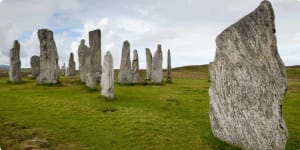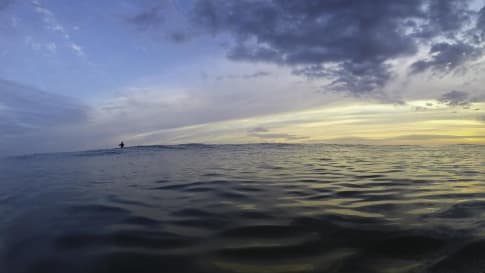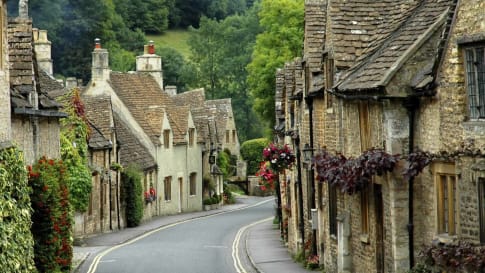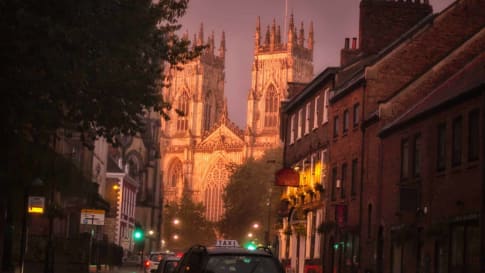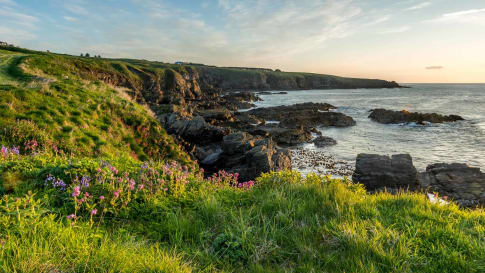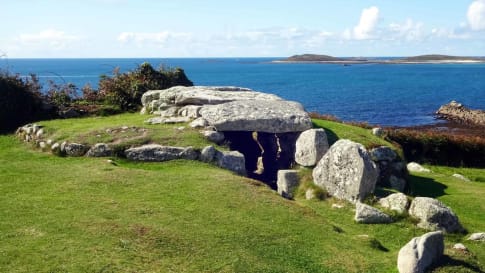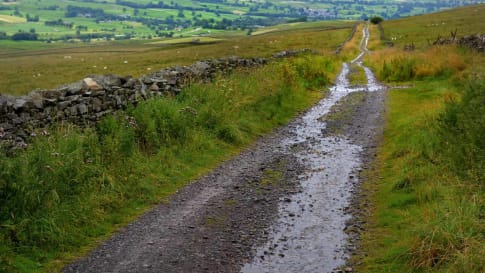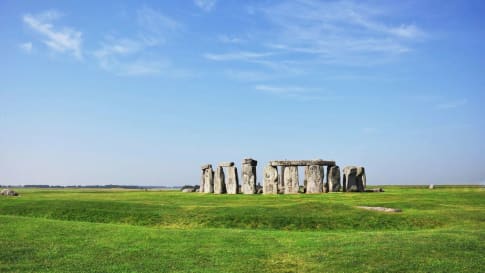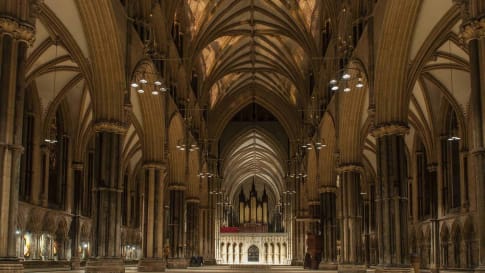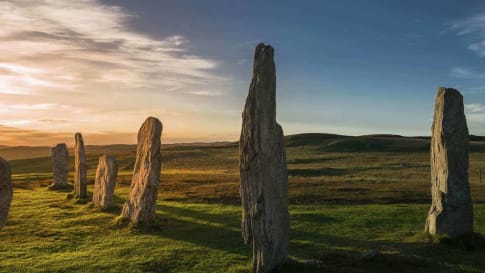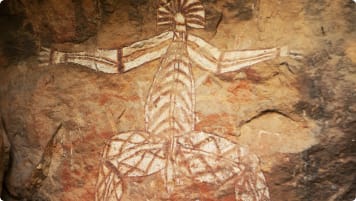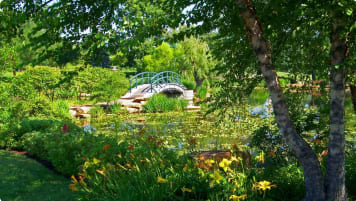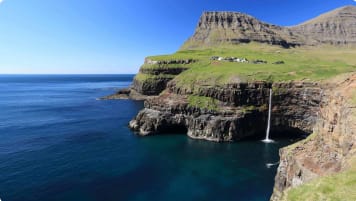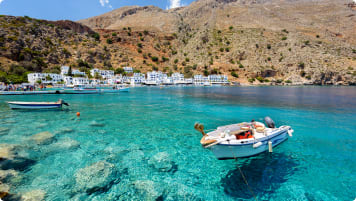Prehistoric Britain small group history tour including standing stones
This guided tour invites you to explore UNESCO World heritage sites at Skara Brae in the Orkneys, Isle of Skye, and Stonehenge in a prehistoric tour. This escorted tour has trips to key sites in Scotland, and the Irish sea in Wales such as Gower Peninsula and National Museum in Cardiff and England. Each day tour is supported by local guides.
From £8,700GBP
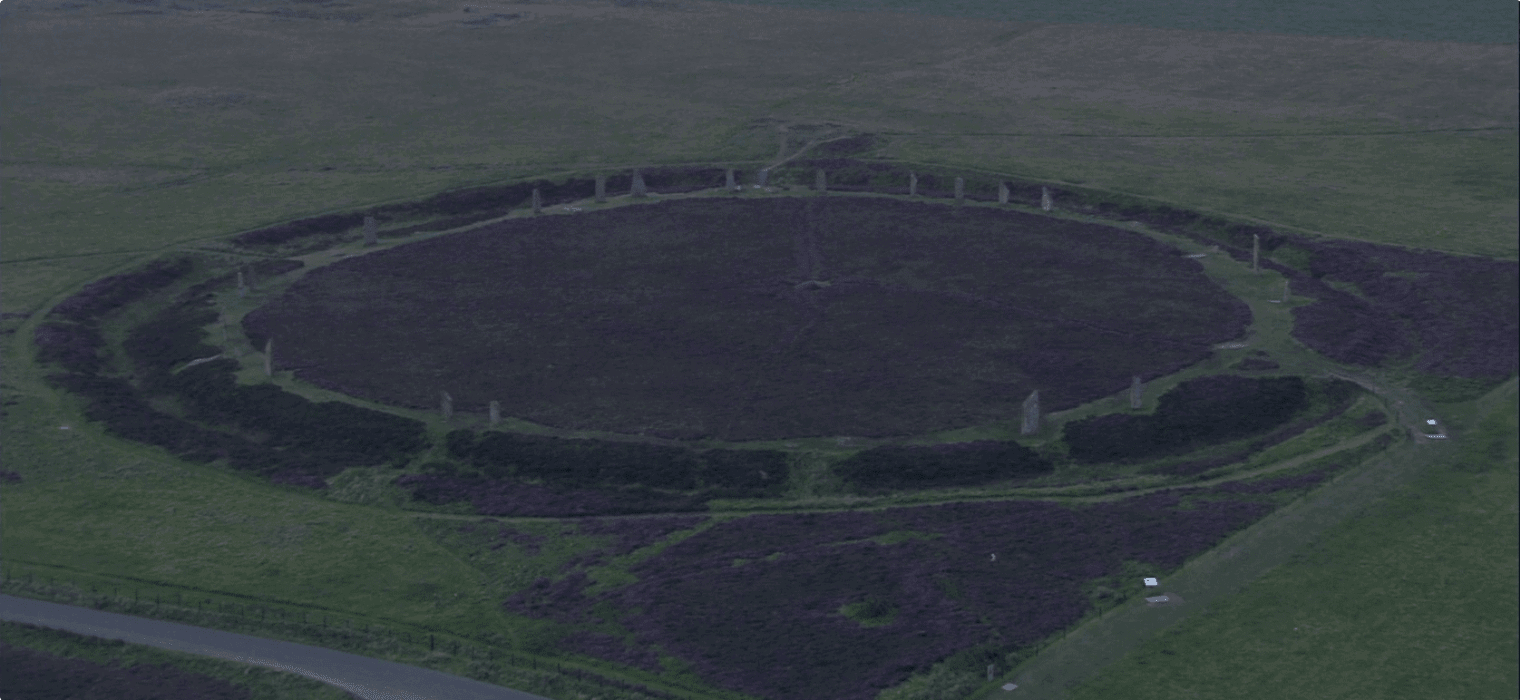
Highlights
- 1. See the heritage listed Iron Age sites in Shetland.
- 2. Visit the National Museum Cardiff.
- 3. Explore engaging landscapes from the Scottish Isles and Highlands, to the Lake and Peak districts, to the Welsh coast, to the Cotswalds.
- 4. Marvel at the huge stone tombs of Stonehenge.
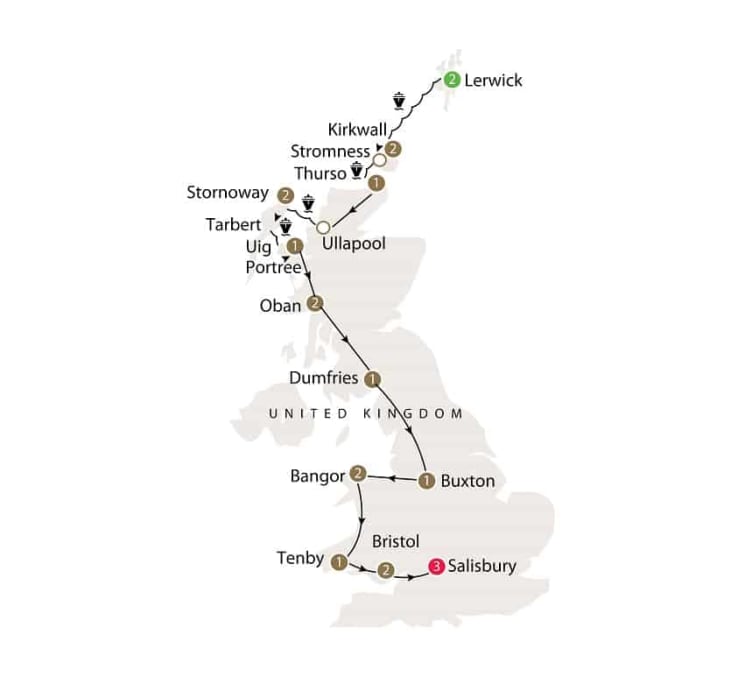
Departure Dates
| Departure Date | Price |
|---|---|
| 08 August 2025 Ends 28 August 2025 • 21 days £8,700 Twin £10,180 Single Pre-guaranteed | Selected |
| 10 August 2026 Ends 30 August 2026 • 21 days £8,700 Twin £10,180 Single Available |
Small group tour Prehistoric Britain
Odyssey offers easy, convenient, and relaxed escorted small group tours across Western Europe and Britain. We explore Britain's neolithic, ancient Roman, and Imperial heritage, its World Heritage Sites, and world famous cities, all with some truly spectacular scenery along the way. This and more is all waiting to be explored on one of Odyssey’s small group tours of Britain, designed for the senior traveller, and led by experienced, and enthusiastic like minded people.
With roughly half-a-million years of humanoid occupation in Britain before the coming of the Romans and the first written historic records, a rich set of prehistoric artefacts exist both on and in the ground throughout Britain. During this Prehistoric Britain tour you have the opportunity to see Neolithic monuments, Bronze Age sites, burial mounds, and standing stones, and learn about Britain's natural history and prehistoric life.
Our journey through prehistoric history starts in Lerwick in the Shetland Islands of far north Scotland. Over the next 21 days this fully escorted Prehistoric Britain tour for the mature traveller moves south via Thurso through Scotland, England and Wales. Your tour concludes with 3 nights in Salisbury. During one of these days in Salisbury, you will have the opportunity to witness dawn at Stonehenge as part of a group visit.
Highlights of our tour
On this guided tour we explore many of the most important prehistoric sites in Britain. You will visit:
- the classic standing stone rings in Orkney
- excavated villages in Shetland and the Orkney Islands
- Visit An Corran, one of the oldest archaeological sites in Scotland on the Isle of Skye
- Dunadd Fort, which dates back to the late Neolithic Age, near Oban
- the standing stones in the Outer Hebrides
- the tomb sites on the isle of Anglesey in Wales
- Rollwright Stones in the Cotswolds
- the stone circle of Castlerigg, set among the dramatic landscapes of the Lake District
- the vast circular earthen henges around Avebury and Stonehenge, a UNESCO World Heritage Site
What you will learn
Our small group tour of Prehistoric Britain draws from local experts who join the tour to give talks about their specialist topics to enhance your learning of the subject. This trip will take us out of the city, and into the natural beauty of the British country visiting many of Britain's World heritage sites. Our sites feature large, often megalithic, structures that have been studied by archaeologists. Short walking tours of the significant ancient sites allow participants to appreciate archaeologists' interpretations of how each was constructed. You have time to learn and understand their inferred purposes, and the age of the structures. During our main site visits, a guide will be on hand to explain the features of that site and to comment on other points of interest.
Who enjoys travelling on an Odyssey Tour?
This Prehistoric Britain small group history tour including standing stones is suitable for couples and the single traveller. It is specially designed for people seeking to extend their first hand knowledge through learning with local experts and visiting the sites. Most travel on this Discovery Tour is by mini-coach and ferry, though some days we will have a walking tour of our heritage site. During the tour you stay in comfortable accommodation in nearby villages and towns, with en-suite facilities. The small group tour will be led by an Odyssey Traveller tour guide. Our tours really are 'small group tours', allowing you to meet like-minded people while having unique experiences.
You can read our article on new discoveries about Britain’s Stone Circles.
Click through to read related articles:
- Exploring Britain’s Neolithic Past
- Neolithic Burial Chambers: Telescopes to the Stars
- Standing Stones in Prehistoric Britain
If you'd like to learn more about touring Great Britain, read our blog post here!
For more details, click the ‘Top 5’ or ‘Itinerary’ buttons above! If you’re keen to experience this tour, please call or send an email. Or, to book, simply fill in the form on the right hand side of this page.
Gallery
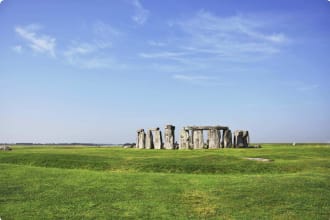
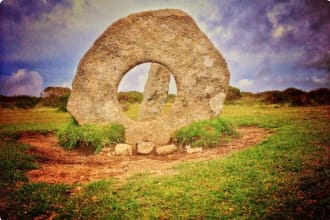
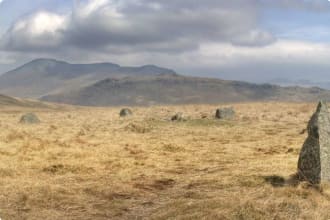
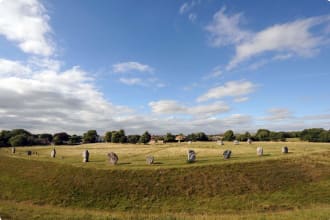
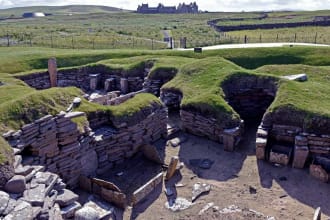
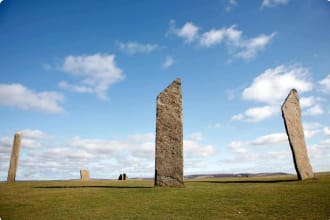
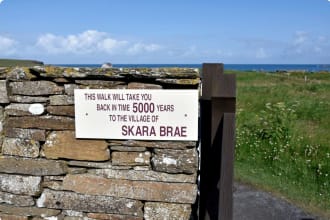
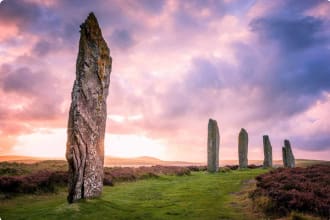
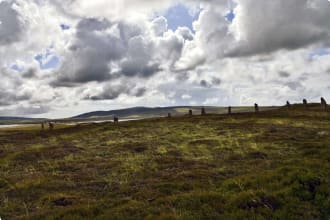
Itinerary
21 days
Day 1: Lerwick
Accommodation: 2 nights at The Shetland Hotel or similar
Make your own way to our hotel in Lerwick on Shetland Island. In the evening we get together for our welcome dinner. (D)
Day 2: Lerwick
Accommodation: The Shetland Hotel or similar
Today we enjoy a full day tour of the island. We travel by bus to Sandsayre where we board a boat to Mousa Island. There we’ll walk to Mousa Broch, a beautifully preserved round stone tower, the most complete of the 500 plus other brochs in Scotland. We will complete the day with a drive to our hotel in Lerwick. (D)
Day 3: Kirkwall
Accommodation: 2 nights at Orkney Hotel or similar
After breakfast we will have a full day tour of the area including a visit to Ronas Hill, a Neolithic chambered cairn (conditions permitting). This will be followed by sightseeing, including the very dissected coastline of the island and Scalloway. The museum in Scalloway illustrates some of Shetland’s historic connections with the Scandinavian countries and the important role played by the locals during WWII. We will end our time on Shetland with a visit to the Jarlshof site, one of the 2 main prehistoric sites on Shetland’s Mainland. The Neolithic, Bronze Age, Iron Age, and Pictish artefacts and buildings at the Jarlshof site were initially uncovered by stormy sea waves, then by excavation beginning in the late 1940s. We will take the late afternoon ferry from Lerwick to Kirkwall, the main township on Mainland Orkney. Dinner on board will be at own expense. Upon arrival in Kirkwall around 11:30 pm we will be picked up and taken to our hotel. (B)
Day 4: Kirkwall
Accommodation: Orkney Hotel or similar
Today we will visit Orkney, which is a real treasure house for our tour featuring many prehistoric sites particularly from the Bronze and Iron Ages. After breakfast we will enjoy a full day of visits to a number World Heritage Sites including the Stones of Steness, the Ring of Bodgar, the ancient chambered tomb Maes Howe, the excavated Neolithic settlement Skara Brae, and Gurness Broch. When we return to our hotel, we will enjoy the evening at leisure. (B)
Day 5: Melvich
Accommodation: 1 night at St. Clair Hotel or similar
After breakfast we will visit the underground Rennibister Earth House and the Isbister chambered cairn on the edge of a cliff- locally known as the Tomb of the Eagles. We will take a leisurely drive back along the south coast of west mainland to view Scapa Flow and the south islands. Before our ferry to mainland Scotland we will visit Unstan cairn, a neolithic chambered tomb. Our ferry will depart Stromness at 4:45pm for the 2.5 hour crossing to Scrabster. A bus will pick us up from the ferry to bring us to our accommodation at Thurso township. We will enjoy dinner at the hotel. (B,D)
Day 6: Stornoway
Accommodation: 1 night at Royal Hotel or similar
Today’s travel will take us across the sparsely populated north-western corner of Scotland, from the Pentland Firth across Sutherland to Ullapool. We will travel from Thurso via Hope, then south to see another of the late prehistoric brochs, Dun Dornaigil. We will travel on to Lairg for lunch. During the day we will pass several lochs before arriving at Loch Broom and Ullapool for our 5:30 pm ferry across the Minch to Stornoway, the main township on the joined islands of Lewis and Harris. We will have a bus pickup in Stornoway after disembarking at 8:00 pm to take us to dinner, before checking in to our accommodation. (B,L,D)
Day 7: Tarbert
Accommodation: 1 night at Hotel Hebrides or similar
After breakfast we will have a full day visiting the highlights of Lewis. Lewis is naturally joined with Harris, and both are composed of some of the oldest rocks on earth. Much of the area is treeless and while Lewis is relatively flat, Harris is quite rugged. Prior to the arrival of the Vikings in the mid 900s AD there had been a human presence here for about 5000 years, and while some of evidence of this past presence is deep under the peat and boglands, some evidence can be seen, including the impressive Neolithic Callanish Standing Stones, the Iron Age Dun Carloway brochy, and the reconstructed Iron Age buildings at Bostah Beach on Great Bernera. We will also explore more modern sites in Lewis such as the thatched “Black House” at Arnol. We continue to our hotel in Tarbert with an evening at leisure. (B)
Day 8: Uig
Accommodation: 1 night at Uig Hotel or similar
Early in the morning we will transfer to the ferry to Uig on the Isle of Skye (ferry departs 7:15 am). We will take a scenic drive to Staffin via the impressive Quiraing basaltic landforms on the eastern side of the Totternish Peninsula. We will see An Corran, which is one of the oldest archaeological sites in Scotland (Mesolithic–Middle Stone Age). In Staffin we will visit the small museum where some Stone Age artefacts are exhibited. One of the main local interests relates to the existence of dinosaur footprints and this too is covered in the museum. After further coastal and mountain sightseeing we will arrive in Uia via Portree for overnight accommodation and dinner. (B,D)
Day 9: Oban
Accommodation: 2 nights at Oban Bay Hotel or similar
We will reach the mainland over the Lochalsh Bridge then visit the last of our brochs, Dun Trodden and Broch Telve near Glenelg. On returning to the main road we will have views of the spectacular Eilean Donan Castle, a castle on an island named after Irish Bishop Donan who was here about 580 AD. We will travel south via Fort William to Oban for our overnight accommodation and dinner. (B)
Day 10: Oban
Accommodation: Oban Bay Hotel or similar
After an early breakfast we will have a busy day of visits to Kilmartin Vale, which is a very rich prehistoric site. Over 320 local ancient monuments date back to Neolithic and Bronze age antiquity, including Nether Largie Standing Stone, Ri Cruin Cairn, Templewood Stone Circle, Baluachraig Cup and Ring Marks, and Glebe Cairn. We will visit the hilltop of Dunadd Fort, which dates back to the late Neolithic Age. Interestingly this site had its greatest use in the 8th and 9th Centuries AD as the centre of the Gaelic kingdom, Dal Riada. It was also the location used for many royal proclamations up to the 20th Century. Please note that the path up to Dunadd Fort is steep and rocky, please ensure you wear appropriate footwear. If time permits we will also visit the relatively modern seaport of Crinan and the canal across the peninsula. We will return to our accommodation at Oban and enjoy an evening at leisure. Oban is a small town protected from the sea offering excellent access for ferries to many islands including the Outer (Western Hebrides) and Mull. South of Oban is a peninsula encompassing Kilmartin Vale and terminating in Kintyre. (B)
Day 11: Dumfries
Accommodation: 1 night at Cairndale Hotel or similar
After breakfast we will take a scenic drive south to Dumfries via Inveraray, past the outskirts of Glasgow to Ayr, then through Galloway, which is famous for its horses and cattle industries. We will also see the Scottish Southern Uplands and Dumfries, and have a diversion at New Galloway to see 2 almost complete Neolithic chambered burial cairns, Holy Chambered Cairn (I & II), near Creetown overlooking Wigtown Bay. Our journey will end with a dinner at our accommodation in Dumfries. (B,D)
Day 12: Buxton
Accommodation: 1 night at Best Western Lee Wood or similar
After breakfast we will pass into England for a number of visits before our arrival in the Peak District. Just north of Penrith we will see Long Meg and Her Daughters, a set of 59 stones in a huge circle constructed in the Late Neolithic-Early Bronze Age, with just under half the stones still standing. We will also visit a local henge with a huge 90 metre diameter, referred to as King Arthur’s Round Table (time permitting). We will go to the Lake District near Keswick and above Derwent Water to see Castlerigg, another stone circle where agricultural activity has scattered stones making it hard for pre historians to give an interpretation of its original purpose. We continue our journey via Keswick with a stop for lunch (own arrangements) and then drive via Peak District to Stanton where we will visit the Nine Ladies, a Bronze Age Stone Circle, named according to the legend that the ladies were literally petrified as a penalty for dancing on a Sunday! (B)
Day 13: Wales
Accommodation: 2 nights at Carreg Bran Hotel or similar
Following breakfast we will venture into the high moors of the Peak countryside to Arbor Low Stone Circle, which is one of the earliest ancient monuments in Britain to have statutory protection. This monument consists of some 50 slabs of white limestone around an 85 metre diameter henge, where all but 1 of the slabs has fallen. We then travel west across Cheshire into Wales to follow the northern coastal road to Llanfair Pwllgwyngyll, with a stop to see Gop Hill outside the village of Trelawnyd. Gop Hill is huge man-made hill described as a Neolithic Cairn located just south of Prestatyn. We will continue west to Penmaenmawr, where we will visit the Penmaenmawr Museum’s stone axe display. This area was an active centre in the prehistoric past and is close to one of the most important stone axe making sites in Europe. We will finish the day at Llanfairpwllgwyngyll, the shortened map name for the town with one of the longest titles in the world. It is located over the Britannia Bridge. (B)
Day 14: Wales
Accommodation: Carreg Bran Hotel or similar
After breakfast we will follow a circular route to visit the main prehistoric sites on the island. The ferry terminal for crossing the Irish Sea to Dublin is located here. We will see Barclodiad y Gawres, which is a Neolithic burial chamber decorated with rock art, as well as Din Lligwy, an ancient settlement with local evidence of a Neolithic burial chamber. Other sites of interest for the day include an Iron Age hut group, a Medieval church, Bronze Age Holyhead Mountain Hut Circles, the complex burial chamber of Trefignath, 2 adjacent Neolithic burial chambers at Presaddfed, and the cairn passage grave of Bryn Celli Ddu, which we can actually walk into. Our local guide will arrange the order of visits. In the afternoon we will return to our accommodation and an evening at leisure. (B)
Day 15: Tenby
Accommodation: 1 night at Fourcroft Hotel or similar
We will leave after breakfast for a coastal drive south to the delightful walled seaside town of Tenby via Aberystwyth. On the way south we will make 2 stops with a local guide between Cardigan and Newport to visit Castell Henllys, an Iron Age hillfort. Replica Iron Age buildings are situated near the original hillfort. We also visit Pentre Ifanis, a beautiful dolmen (tomb) constructed of megaliths. Pentre Ifanis was the first Welsh ancient site to be scheduled in 1884. Upon arrival in Tenby, we will enjoy dinner in Tenby. (B,D)
Day 16: Bristol
Accommodation: 2 nights at Bristol Hotel or similar
After breakfast we will travel east toward Cardiff. En route we will travel to sites on the Gower Peninsula, recognized for its outstanding natural beauty, and Oxwich Bay, claimed to be the most beautiful beach in the world! Nearby we will visit Parc-le-Breos, a long barrow tomb from Neolithic times that has access to the burial chamber via a passageway. We then travel via Swansea to Cardiff to visit the archaeology galleries of the National Museum of Wales, to be followed by a walk near St. Nicholas to see Tinkinswood, a megalithic burial chamber of huge proportions. This afternoon we will travel back into England over the Severn Estuary and stop in Bristol. (B)
Day 17: Bristol
Accommodation: Bristol Hotel or similar
Today a local guide will join us after breakfast to take us across the Cotswolds for a visit to Rollright Stones, located near Chipping Norton northwest of Bristol. Rollright Stones consists of 3 different structures including a dolmen (The Whispering Knight), a stone circle (The Kings Men), and a single stone (The Kings Stone), each constructed at different prehistoric times and with individual purposes. After lunch in the pretty town of Bourton-on-the-Waters, we will visit the spectacular Uffington White Horse, outlined with trenches of chalk and constructed during the Bronze Age. Our drive back to Bristol will take us to the last visit of the day at Stanton Drew Circles, considered by many to be one of the most impressive monuments to have been built. The largest of the 3 circles here, the Great Circle, has a diameter of 113 metres and is surrounded by a still larger ditch. The stones forming the circles and avenues, both standing and fallen, are massive blocks of sandstone, breccia, or limestone. (B)
Day 18: Salisbury
Accommodation: 3 nights at Red Lion Hotel or similar
Overview: Today we will depart to Salisbury where we will meet our specialist guide for a visit to Maiden Castle, which dates back 4000 years. This site is described by English Heritage as the largest and most complex hillfort in Europe, with the whole structure spread over several hectares. The area was used as an agricultural site during the Bronze Age (about 1800 BC), but other groups such as the Romans also used the site in the 4th Century AD. Over 30 other hillfort sites have been identified in Dorset and it is proposed that their purpose may have been to control agricultural land and for defence purposes when required. In the afternoon we will continue our journey via Cerne Abbas. After we settle into our hotel, our guide will have a short lecture for the group about the local prehistory and to put it into context with other sections of our tour. Tonight is an evening at leisure. (B)
Day 19: Salisbury
Accommodation: Red Lion Hotel or similar
After breakfast we will travel to Avebury to have a guided walking tour to see the famous stone circle and other interesting features that make up this Neolithic henge (circular, ritual earthwork) now listed as a World Heritage Site. A visit to the Wiltshire Museum in Devizes is our next stop. This museum has an archaeological collection from sites in Wessex. We will also visit Silbury Hill, which is listed in Wessex as a World Heritage Site. It is an artificial chalk and clay hill 40 metres high, making it the tallest prehistoric site in Europe. (B)
Day 20: Salisbury
Accommodation: Red Lion Hotel or similar
After an early breakfast we will transfer to Stonehenge for a “special access” walk among the stone circles with our local guide. We will learn more about the building and original structures of this site which was particularly active during the 3rd millennium BC as Britain’s largest cemetery. Evidence for this claim has been strongly supported through the efforts of the Stonehenge Riverside Project which was most active in the field between 2003 and 2009. A major objective of the project was to investigate the relationship between Stonehenge and the many surrounding monuments and features. The project has also found a new henge, called Bluestonehenge, and has established the origins of Stonehenge to be 500 years earlier than previously believed. We will then move to Woodhenge which is also within the local World Heritage Site and about 3 kilometres north of Stonehenge. This henge consists of 6 oval concentric rings of postholes, with each ring originally outlined with timber posts. The outer ring is 110 metres in diameter. Original construction was around 2000 BC with further evidence of use until about 1800 BC. The circles were first identified from the air, and concrete posts now occupy the spots originally filled with the wooden posts On the way back to Salisbury, we will pass Old Sarum, which is a few kilometres north of Salisbury. It is the site of an Iron Age fort where a first Salisbury Cathedral once stood. Our day will end with a farewell dinner at our accommodation in Salisbury. (B,D)
Day 21: Salisbury
The tour will end after breakfast. Salisbury has excellent rail connections to London for onward travel connections. (B)
Tour Notes
- This tour involves a boat ride in Shetland to Mousa Broch, and a flight and ferry transfers between several of the Scottish islands.
- For some day excursions we are away from food outlets so provision will be made to purchase sandwiches, etc before we set out for the day.
Includes / Excludes
What’s included in our Tour
- 20 nights accommodation.
- 20 breakfasts, 1 lunch, 9 dinners.
- All field trips and associated entry fees as per the itinerary.
- Services of tour leader for the duration of tour.
What’s not included in our Tour
- International flights and departure tax.
- Comprehensive international travel insurance.
- Meals not specified in the itinerary.
- Items of a personal nature such as telephone calls and laundry.
Participants must be able to carry their own luggage, climb and descend stairs, be in good health, mobile and able to participate in 3-5 hours of physical activity per day, the equivalent of walking / hiking up to 8 kilometers per day on uneven ground.
Book now
Make it a private tour
Easing your journey
Crossing international borders with restrictions
The list of requirements to travel internationally has changed and will continue to change for several years. Odyssey is here to assist you in managing your way through these requirements:
For more information see our Crossing international borders with restrictions page.
Book With Confidence
If less than 30 days before your tour starts you are unable to travel as a result of Government travel restrictions, Odyssey Traveller will assist you with a date change, provide you with a credit or process a refund for your booking less any non-recoverable costs.
See Terms and conditions for details.
Peace of Mind Travel
The safety of our travellers, tour leader, local guide and support staff has always been our top priority and with the new guidelines for public health and safety for keeping safe for destinations around the world, we’ve developed our plan to give you peace of mind when travelling with us.
See Peace of Mind Travel for details.
Reviews
Excellent itinerary, transport and local guides!
Participant 2016
Reading List Download PDF
Prehistoric Britain (Routledge World Archaeology) 2010
Timothy Darvill
Britain has been inhabited by humans for over half a million years, during which time there were a great many changes in lifestyles and in the surrounding landscape. This book, now in its second edition, examines the development of human societies in Britain from earliest times to the Roman conquest of AD 43, as revealed by archaeological evidence. Special attention is given to six themes which are traced through prehistory: subsistence, technology, ritual, trade, society, and population.
Prehistoric Britain begins by introducing the background to prehistoric studies in Britain, presenting it in terms of the development of interest in the subject and the changes wrought by new techniques such as radiocarbon dating, and new theories, such as the emphasis on social archaeology. The central sections trace the development of society from the hunter-gatherer groups of the last Ice Age, through the adoption of farming, the introduction of metalworking, and on to the rise of highly organized societies living on the fringes of the mighty Roman Empire in the 1st century AD. Throughout, emphasis is given to documenting and explaining changes within these prehistoric communities, and to exploring the regional variations found in Britain. In this way the wealth of evidence that can be seen in the countryside and in our museums is placed firmly in its proper context. It concludes with a review of the effects of prehistoric communities on life today.
With over 120 illustrations, this is a unique review of Britain's ancient past as revealed by modern archaeology. The revisions and updates to Prehistoric Britain ensure that this will continue to be the most comprehensive and authoritative account of British prehistory for those students and interested readers studying the subject.
Britain Begins
Barry Cunliffe
The last Ice Age, which came to an end about 12,000 years ago, swept the bands of hunter gatherers from the face of the land that was to become Britain and Ireland, but as the ice sheets retreated and the climate improved so human groups spread slowly northwards, re-colonizing the land that had been laid waste. From that time onwards Britain and Ireland have been continuously inhabited and the resident population has increased from a few hundreds to more than 60
million.
Britain Begins is nothing less than the story of the origins of the British and the Irish peoples, from around 10,000BC to the eve of the Norman Conquest. Using the most up to date archaeological evidence together with new work on DNA and other scientific techniques which help us to trace the origins and movements of these early settlers, Barry Cunliffe offers a rich narrative account of the first islanders - who they were, where they came from, and how they interacted one with
another. Underlying this narrative throughout is the story of the sea, which allowed the islanders and their continental neighbours to be in constant contact.
The story told by the archaeological evidence, in later periods augmented by historical texts, satisfies our need to know who we are and where we come from. But before the development of the discipline of archaeology, people used what scraps there were, gleaned from Biblical and classical texts, to create a largely mythological origin for the British. Britain Begins also explores the development of these early myths, which show our ancestors attempting to understand their origins. And,
as Cunliffe shows, today's archaeologists are driven by the same desire to understand the past - the only real difference is that we have vastly more evidence to work with.
Britain BC: Life in Britain and Ireland Before the Romans
Francis Pryor
An authoritative and radical rethinking of the history of Ancient Britain and Ancient Ireland, based on remarkable new archaeological finds.
British history is traditionally regarded as having started with the Roman Conquest. But this is to ignore half a million years of prehistory that still exert a profound influence. Here Francis Pryor examines the great ceremonial landscapes of Ancient Britain and Ireland – Stonehenge, Seahenge, Avebury and the Bend of the Boyne – as well as the discarded artefacts of day-to-day life, to create an astonishing portrait of our ancestors.
This major re-revaluation of pre-Roman Britain, made possible in part by aerial photography and coastal erosion, reveals a much more sophisticated life in Ancient Britain and Ireland than has previously been supposed.
This edition does not include illustrations.
Flag Fen: A Concise Archæoguide
Francis Pryor
Flag Fen is one of the best-preserved Late Bronze Age sites yet found in Britain. It was discovered in 1982 and consists of many tens of thousands of timbers which were driven into the muddy waters of a fen on the outskirts of modern Peterborough, between about 1300 and 900 BC. Hundreds of valuable objects, including swords, daggers and jewellery, were dropped into the water around the timbers, as offerings.
Flag Fen was opened to the public in 1987 and is now a major visitor attraction. It was also the subject of a first-of-its-kind crowdsourced and crowdfunded archaeological dig during the summer of 2012, organised by Digventures.
This specially commissioned work, written by archaeologist and discoverer of Flag Fen, Francis Pryor MBE, provides a concise companion to anyone seeking an authoritative introduction to this remarkable site.
Stonehenge: Exploring the greatest Stone Age mystery
Mike Parker Pearson
Our knowledge about Stonehenge has changed dramatically as a result of the Stonehenge Riverside Project (2003-2009), led by Mike Parker Pearson, and included not only Stonehenge itself but also the nearby great henge enclosure of Durrington Walls. This book is about the people who built Stonehenge and its relationship to the surrounding landscape. The book explores the theory that the people of Durrington Walls built both Stonehenge and Durrington Walls, and that the choice of stone for constructing Stonehenge has a significance so far undiscovered, namely, that stone was used for monuments to the dead. Through years of thorough and extensive work at the site, Parker Pearson and his team unearthed evidence of the Neolithic inhabitants and builders which connected the settlement at Durrington Walls with the henge, and contextualised Stonehenge within the larger site complex, linked by the River Avon, as well as in terms of its relationship with the rest of the British Isles. Parker Pearson's book changes the way that we think about Stonehenge; correcting previously erroneous chronology and dating; filling in gaps in our knowledge about its people and how they lived; identifying a previously unknown type of Neolithic building; discovering Bluestonehenge, a circle of 25 blue stones from western Wales; and confirming what started as a hypothesis - that Stonehenge was a place of the dead - through more than 64 cremation burials unearthed there, which span the monument's use during the third millennium BC. In lively and engaging prose, Parker Pearson brings to life the imposing ancient monument that continues to hold a fascination for everyone.
The Making of the British Landscape: How We Have Transformed the Land, from Prehistory to Today
Francis Pryor
This is the changing story of Britain as it has been preserved in our fields, roads, buildings, towns and villages, mountains, forests and islands. From our suburban streets that still trace out the boundaries of long vanished farms to the Norfolk Broads, formed when medieval peat pits flooded, from the ceremonial landscapes of Stonehenge to the spread of the railways - evidence of how man's effect on Britain is everywhere. In The Making of the British Landscape, eminent historian, archaeologist and farmer, Francis Pryor explains how to read these clues to understand the fascinating history of our land and of how people have lived on it throughout time. Covering both the urban and rural and packed with pictures, maps and drawings showing everything from how we can still pick out Bronze Age fields on Bodmin Moor to how the Industrial Revolution really changed our landscape, this book makes us look afresh at our surroundings and really see them for the first time.
The Celts
Alice Roberts
The Celts are one of the world's most mysterious ancient people. In this compelling account, Alice Roberts takes us on a journey across Europe, uncovering the truth about this engimatic tribe: their origins, their treasure and their enduring legacy today. What emerges is not a wild people, but a highly sophisticated tribal culture that influenced the ancient world - and even Rome.
It is the story of a multicultural civilization, linked by a common language.
It is the story of how ideas travelled in prehistory, how technology and art spread across the continent.
It is the story of a five-hundred year fight between two civilizations that came to define the world we live in today.
The Sea Kingdoms: The History of Celtic Britain and Ireland
Alistair Moffat
The most powerful representation yet of the race which has repeatedly changed history as we know it' - The Scotsman 'Brimming with interesting facts ... instructive and wide-ranging' - Cal McCrystal, Independent on Sunday 'The best picture of the Celtic race yet written' - South Wales Echo 'Lovingly traces the remnants of a once-powerful people through language, ancient place names, farms, fortresses, harbours and, most of all, through their connection to the sea' - Irish Times Alistair Moffat's journey, from the Scottish islands and Scotland, to the English coast, Wales, Cornwall and Ireland, ignores national boundaries to reveal the rich fabric of culture and history of Celtic Britain which still survives today. This is a vividly told, dramatic and enlightening account of the oral history, legends and battles of a people whose past stretches back many hundred of years. The Sea Kingdoms is a story of great tragedies, ancient myths and spectacular beauty.
The Celtic Myths: A Guide to the Ancient Gods and Legends
Miranda Aldhouse-Green
Introduces the world of the Celts, their gods and goddesses, heroes, monsters and villains.
As well as vividly exploring the tales, the author brings her expertise in the archaeology of the Iron Age and particularly shamanism to bear on the mythical worlds she describes, with evidence as diverse as the Gundestrup Cauldron and the famous bog bodies.
Starting with a discussion of how myths are transmitted and by whom, the author continues with an account of the Irish and Welsh myths and their key actors and motifs, before moving on to consider themes such as heroes, animals, women, environment and the Otherworld. Finally, the author asks how the myths survived the Christianization of Europe and looks at the influence of monastic chroniclers on the tales, which they preserved and adapted. Includes more than 80 illustrations
Iron Age Britain
Barry Cunliffe
This revised introduction to Britain in the first millennium BC incorporates modifications to a story that is still controversial. It covers a time of dramatic change in Europe, dominated by the emergence of Rome as a megastate. In Britain, on the extremity of these developments, it was a period of profound social and economic change, which saw the end of the prehistoric cycle of the Neolithic and bronze Ages, and the beginning of a world that was to change little in its essentials until the great voyages of colonization and trade of the 16th century. The theme of the book is that of social change within an insular society sitting on the periphery of a world in revolution.
Standing Stones
Beth Camp
In 1842, Lord Gordon claims his new estate in Northern Scotland and plans to replace farmers and fishermen with sheep. Mac McDonnell, suspicious of Lord Gordon from the beginning, leads protests – despite the impact his actions will have on his sister and three brothers. When evictions begin, a second protest at Westness turns violent. What will Mac risk to protect his family, his sweetheart, and his livelihood?
Set in the Orkney Islands during the time of the Clearances, Standing Stones won an award from the Pacific Northwest Writers Association for historical fiction and was called “a very promising work, with appeal to a broad audience, peppered with a variety of characters the reader can identify with sympathetically or instantly distrust.”
